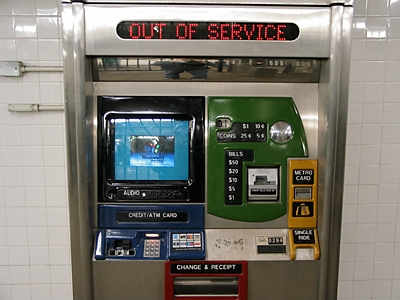»Reviving an extinct art.
How many ways do you know to scam MetroCard fares?
http://www.nytimes.com/2004/02/03/nyregion/03subway.html
February 3, 2004
MetroCard Dispensers Breaking Down, Victims of Tampering and Their Own Success
By MICHAEL LUO
Not quite nine months after the orange, yellow and blue MetroCard became the only way to get through a subway turnstile in New York City, transit workers are called to fix the vending machines that dispense them roughly 800 times a day — with 1,637 machines in the entire system, statistics show.
With each muttered curse from a passenger as a missed train rumbles past, the token's flashy, flexible replacement — the centerpiece of an ambitious vision of a 21st-century transit system — is securing its place in the city's landscape as something to complain about.
"It affects everybody," said Rey Labron, 39, a messenger in Harlem, as he stood in line at a subway booth at East 125th Street because all three MetroCard machines in the station were scrolling the red message "Out of Service" on their L.E.D. displays. "It makes you go to work late when you have to wait on a big line."
To be fair, some repairs involve repeated problems at the same machines, and most of the time the machine is not completely out of order. More often, it is not taking bills, or is refusing to dispense single-ride tickets, or is experiencing some other problem that does not make it absolutely impossible to buy a MetroCard - although that may be little solace to the rider whose bill a machine will not take. And often, the problem cannot be blamed on the machine but rather on the scam artists who have tampered with it. With repeats figured in, officials estimate that about one-third of all the machines are getting some type of service each day.
MetroCard machine repairs have nearly doubled since tokens were eliminated in May, and New York City Transit is looking to increase its crew of MetroCard machine maintainers by 60 percent, to 108, at a cost of $3 million, even as many of its other departments endure cutbacks.
Call it the price of change.
The half-century-old subway token was no match for the MetroCard, its high-tech replacement. MetroCards are critical to transit officials' visions of a 21-century subway system, in which riders buy their fare cards from vending machines, follow electronic voices and signs and ride trains that are controlled almost completely by computer. As part of this effort, the transit agency closed 45 subway booths last August, replacing them with MetroCard vending machines. Seventeen more are to close in coming months.
But by now, most New Yorkers are deeply familiar with occasional MetroCard frustration: entire rows of machines out of order; long lines behind the only working machine or the only one that will take cash; getting to the front of the line to have a machine eat your $5 bill or to discover that it will not take your credit card.
"Just give me my token and let me use it," said Darryl Gates, 39, a journeyman at the Fulton Fish Market, looking to buy a single-ride card from a machine that was being fixed on a recent morning.
The root of the problem, officials said, is not the machines themselves but vandalism and the demands of a 24-hour transit system. Over all, they said, the MetroCard system is a huge success. "There's always going to be issues," said Steven Frazzini, vice president of MetroCard program management and sales, pointing out that the machines processed more than 101 million transactions last year. "They're getting a lot of use."
The nation's second-largest municipal rail system is Chicago's, which carries 1.5 million riders a day, compared to more than 4 million in New York. In Chicago, fare cards are sold only through vending machines, and repair crews respond to about 60 calls a day for 340 machines, a spokeswoman for the Chicago Transit Authority said. In Washington, whose subway system transports 650,000 riders a day, fare card machines work 99.6 percent of the time. But Washington's system and parts of Chicago's shut down overnight. All three cities use machines made by the same manufacturer, Cubic Automated Revenue Systems.
After the vending machines' initial rollout in 1999 in New York, they were failing far more often than transit officials had promised - once every 2,000 transactions, instead of every 10,000 transactions. But after some adjustments, the machines now fail at a rate of about once every 12,000 transactions. The number is deceptive because it does not take into account common headaches like the bill handler getting jammed with an old bill.
"A customer has five one-dollar bills, two fives and a ten," said Paul Korszak, assistant vice president of MetroCard sales and customer service. "It just takes one of those out of a sweaty pocket to introduce a jam."
The problems have created more than a few busy days for the mobile teams responsible for keeping the machines running. Louis Maldonado, 39, and his armed partner, Michael Hickman, 61, were camped the other day in front of two machines at the William and Fulton Streets entrance of the Broadway-Nassau subway station. After fixing a half-dozen machines at another station earlier in the morning, they arrived to find the two machines not taking bills.
The problem turned out to be vandalism: Mr. Maldonado reached into both machines and fished out MetroCards stuck in their bill-handling units.
Of 25,382 repairs in December, 16,936 involved the bill-handling unit. About 45 percent of these - or 30 percent of all repairs - were caused by tampering. The tamperer's goal is to break the machine so that riders will be forced to use the services of a person who just happens to be waiting nearby with a handful of unlimited-ride day passes offering to swipe people through for $2.
"They start a transaction," said Antonio Suarez, chief officer of automated fare collection equipment maintenance for the transit agency. "Instead of money, they introduce a card or a foreign object."
"What these guys will do is they will purchase multiples of those cards and just switch them as they're swiping people through and charge them two bucks apiece," said Paul J. Browne, the chief spokesman for the New York City Police Department.
The scam was in full view on a recent afternoon at the station at 125th Streeet and Lexington Avenue, where a group of men jostled to swipe riders through the turnstiles. All three MetroCard machines in the station were out of commission.
Officials say the scam represents an evolution of the extinct art of "token sucking," in which a person would clog the token slot with a matchbook or even glue. After the stymied rider walked away, the token sucker would clamp his lips over the receptacle and suck the token out, then turn around and resell it. The scam produced repair headaches similar to those the transit agency is experiencing with MetroCard. Repair crews used to fix turnstiles at a clip of about 250 a day, about 60 percent of them because of paper stuffed in the token slots.
Some of the swipers of today, as they are nicknamed, have stumbled upon a MetroCard quirk in which someone can bend a discarded card a certain way, then swipe it through a card reader three times quickly and somehow end up with a $2 credit.
A man who called himself Charlie and said he was 31 demonstrated for a reporter at the station at 103rd Street and Lexington Avenue.
"I can make $200 or $300 a day," he said. "This morning, I got here at 11. By 11:30, I made $25. Then I went to 125th Street. Up there, I made $30 in 15 minutes."
"The most I ever did was $250," he said. "That day I worked from 9 in the morning until 5."
Transit officials confirmed the problem but said it had not been fixed because that would make it harder to swipe legitimate cards through the turnstiles.
Officials for Washington's Metro said that their fare card dispensing machines were almost never tampered with and that fare swiping was not a problem, largely because riders were required to insert their fare cards when they went through the turnstiles to the subway and when they exited. Officials in Chicago reported a similar lack of vandalism.
After finishing with the two machines at Broadway-Nassau, Mr. Maldonado and Mr. Hickman moved on to the Chambers Street station of the C and E lines, where swipers had struck as well. Mr. Maldonado had planned to start on the southern end, where one machine was out, but after calling in to his headquarters, he learned of an "all out" condition on the other side. When he arrived, he found three broken vending machines, two of them unable to accept bills and a third unable to accept bills or dispense single-ride cards.
Swipers can be charged only with a transit violation, "unauthorized fare media," which carries a fine of $65 or occasionally a jail sentence of one to two days, Mr. Browne said. Because the crime does not rise to the level of a misdemeanor, he added, an officer must see the fare swiper in the act more than once to make an arrest.
Legislation is pending in Albany to elevate the crime to a misdemeanor. Even so, police officers made 2,033 arrests for fare swiping last year, with the monthly arrest average jumping from 134 to 194 after tokens were eliminated. Officers also issued 1,600 summonses for fare swiping.
Another frequent problem is with what officials call the "fare card transportation module," which processes, encodes and dispenses MetroCards. Problems with the fare card system account for about 13 percent of repairs. The rest are typically for the single-ride-ticket dispenser, the coin-accepting mechanism or the receipt system.
Officials said they had tried to build redundancies. If the bill accepter is not working, customers can use credit cards. If the MetroCard dispenser does not work, they can buy single-ride cards. In the rare case when a machine is completely out of service, they can go to a station agent, or try one of the 600 express machines throughout the system, which take only credit and debit cards and seldom have problems.
But the problems with the bill handler are clearly a concern because about three-quarters of transactions at MetroCard machines are in cash. The best they can do, officials said, is to get to the problems more quickly.
The turnaround time for fixing a machine has improved. Machines were out of order anaverage of 15.7 hours in June, a month after the token was eliminated. That dropped to a low of 10.4 hours in November, largely because officials switched to an overlapping shift system that made sure workers were on hand at busy hours. They also asked their workers to work overtime and added extra weekend crews.
Mr. Maldonado and Mr. Hickman finished up with the three machines at Chambers Street and headed south to the World Trade Center station. Swipers regularly position themselves at the unsupervised entrance, so they decide they should check it before they move on.
Sure enough, five out of six machines had error messages.
"They were here," Mr. Maldonado said.
He set down his bag and got to work.
Colin Moynihan contributed reporting for this article.
Copyright 2004 The New York Times Company | Home | Privacy Policy | Search | Corrections | Help | Back to Top


